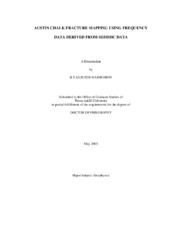| dc.contributor.advisor | Watkins, Joel S. | |
| dc.creator | Najmuddin, Ilyas Juzer | |
| dc.date.accessioned | 2004-09-30T01:40:38Z | |
| dc.date.available | 2004-09-30T01:40:38Z | |
| dc.date.created | 2003-05 | |
| dc.date.issued | 2004-09-30 | |
| dc.identifier.uri | https://hdl.handle.net/1969.1/34 | |
| dc.description.abstract | Frequency amplitude spectra derived from P-wave seismic data can be used to derive a fracture indicator. This fracture indicator can be used to delineate fracture zones in subsurface layers.
Mapping fractures, that have no vertical offset, is difficult on seismic sections. Fracturing changes the rock properties and therefore the attributes of the seismic data reflecting off the fractured interface, and data passing through the fractured layers. Fractures have a scattering effect on seismic energy reflected from the fractured layer. Fractures attenuate amplitudes of higher frequencies in seismic data preferentially than lower frequencies. The amplitude spectrum of the frequencies in the seismic data shifts towards lower frequencies, when a spectrum from a time window above the fractured layer and below the fractured layer is compared with each other. This shift in amplitudes of frequency spectra can be derived from seismic data and used to indicate fracturing. A method is developed to calculate a parameter t* to measure this change in the frequency spectra for small time windows (100ms) above and below the fractured layer.
The Austin Chalk in South Central Texas is a fractured layer and produces hydrocarbons from fracture zones with the layer (Sweet Spots). 2D and 3D P-wave seismic data are used from Burleson and Austin Counties in Texas to derive the t* parameter.
Case studies are presented for 2D data from Burleson county and 3D data from Austin County. The t* parameter mapped on the 3D data shows a predominant fracture trend parallel to strike. The fracture zones have a good correlation with the faults interpreted on the Top of Austin Chalk reflector.
Production data in Burleson County (Giddings Field) is a proxy for fracturing. Values of t* mapped on the 2D data have a good correlation with the cumulative production map presented in this study. | en |
| dc.format.extent | 2482472 bytes | en |
| dc.format.extent | 62205 bytes | en |
| dc.format.medium | electronic | en |
| dc.format.mimetype | application/pdf | |
| dc.format.mimetype | text/plain | |
| dc.language.iso | en_US | |
| dc.publisher | Texas A&M University | |
| dc.subject | fractures frequency Austin Chalk attributes | en |
| dc.title | Austin chalk fracture mapping using frequency data derived from seismic data | en |
| dc.type | Book | en |
| dc.type | Thesis | en |
| thesis.degree.department | Geology and Geophysics | en |
| thesis.degree.discipline | Geology | en |
| thesis.degree.grantor | Texas
A&M University | en |
| thesis.degree.name | Doctor of Philosophy | en |
| thesis.degree.level | Doctoral | en |
| dc.contributor.committeeMember | Berg, Robert R. | |
| dc.contributor.committeeMember | Barrufet, Maria A. | |
| dc.contributor.committeeMember | Gibson, Richard L. | |
| dc.contributor.committeeMember | Gangi, Anthony F. | |
| dc.type.genre | Electronic Dissertation | en |
| dc.type.material | text | en |
| dc.format.digitalOrigin | born digital | en |


